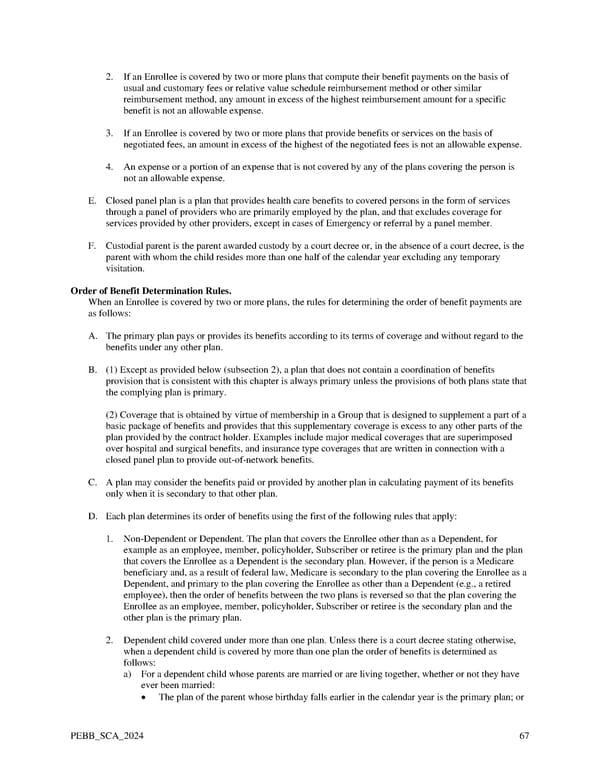2. If an Enrollee is covered by two or more plans that compute their benefit payments on the basis of usual and customary fees or relative value schedule reimbursement method or other similar reimbursement method, any amount in excess of the highest reimbursement amount for a specific benefit is not an allowable expense. 3. If an Enrollee is covered by two or more plans that provide benefits or services on the basis of negotiated fees, an amount in excess of the highest of the negotiated fees is not an allowable expense. 4. An expense or a portion of an expense that is not covered by any of the plans covering the person is not an allowable expense. E. Closed panel plan is a plan that provides health care benefits to covered persons in the form of services through a panel of providers who are primarily employed by the plan, and that excludes coverage for services provided by other providers, except in cases of Emergency or referral by a panel member. F. Custodial parent is the parent awarded custody by a court decree or, in the absence of a court decree, is the parent with whom the child resides more than one half of the calendar year excluding any temporary visitation. Order of Benefit Determination Rules. When an Enrollee is covered by two or more plans, the rules for determining the order of benefit payments are as follows: A. The primary plan pays or provides its benefits according to its terms of coverage and without regard to the benefits under any other plan. B. (1) Except as provided below (subsection 2), a plan that does not contain a coordination of benefits provision that is consistent with this chapter is always primary unless the provisions of both plans state that the complying plan is primary. (2) Coverage that is obtained by virtue of membership in a Group that is designed to supplement a part of a basic package of benefits and provides that this supplementary coverage is excess to any other parts of the plan provided by the contract holder. Examples include major medical coverages that are superimposed over hospital and surgical benefits, and insurance type coverages that are written in connection with a closed panel plan to provide out-of-network benefits. C. A plan may consider the benefits paid or provided by another plan in calculating payment of its benefits only when it is secondary to that other plan. D. Each plan determines its order of benefits using the first of the following rules that apply: 1. Non-Dependent or Dependent. The plan that covers the Enrollee other than as a Dependent, for example as an employee, member, policyholder, Subscriber or retiree is the primary plan and the plan that covers the Enrollee as a Dependent is the secondary plan. However, if the person is a Medicare beneficiary and, as a result of federal law, Medicare is secondary to the plan covering the Enrollee as a Dependent, and primary to the plan covering the Enrollee as other than a Dependent (e.g., a retired employee), then the order of benefits between the two plans is reversed so that the plan covering the Enrollee as an employee, member, policyholder, Subscriber or retiree is the secondary plan and the other plan is the primary plan. 2. Dependent child covered under more than one plan. Unless there is a court decree stating otherwise, when a dependent child is covered by more than one plan the order of benefits is determined as follows: a) For a dependent child whose parents are married or are living together, whether or not they have ever been married: • The plan of the parent whose birthday falls earlier in the calendar year is the primary plan; or PEBB_SCA_2024 67
 Kaiser Permanente WA SoundChoice EOC (2024) Page 66 Page 68
Kaiser Permanente WA SoundChoice EOC (2024) Page 66 Page 68